The perfect 35mm compact camera does not exist. There are two reasons for this. One is that there are limits to how far you can miniaturize a reliable, durable, easy-to-use camera with a big, bright and ideally parallax-compensated viewfinder. The other is that we – that’s you, me and everyone else who loves the bloody things – cannot agree on what we want. You want automation; I want full manual control. I want versatility; you want ease of use (well, so do I, but not at the expense of versatility). You want flash; I hate it. I don’t want battery dependency; you’ll put up with it. We can’t even agree on the optimum focal length: 28mm? 35mm? 40mm? 45mm? 50mm? All (and more) have been tried. One of the few things on which we can all agree is that it has to take standard 35mm cassettes, though some of us will even compromise on that if the other attractions are great enough.
Probably the definitive 35mm compact is the screw-mount Leica, as made from 1930 to 1960, fitted with a collapsible 5cm lens to match the viewfinder: ideally, an Elmar. Ultra-purists might even prefer the earlier fixed-lens models. The elegant, slim, rounded body and the retractable lens make for a wonderfully compact camera, though adding a lens hood adds to the bulk considerably.

On the other hand, the viewfinders are miserably squinty (except on the post-1956 IIIg, which also had parallax compensation); knob wind is admirably compact, but nothing like as easy as lever-wind; the twin shutter speed dials, with lift-twist-and-drop settings on the high speed dial, are not outstandingly convenient; many (the pre-1932 models, and subsequent Standard and I-series) were scale-focus; some find it hard to load film via the base-plate; there’s no meter, of course; and compared with the 1940 IIIc, with its slightly bigger die-cast body, earlier bodies were harder to build within tolerances for flange-to-film distance and more susceptible to knocks and distortion.
Also, if you wanted any lens other than 50mm, an accessory viewfinder was all but essential. This was partially addressed in the IIIg (50mm + 90mm) and more fully addressed in the bigger, heavier M3 (50-90-135mm, 1954) and M2 (35-50-90 mm, 1957); but the drawbacks lie in “bigger, heavier”. There are numerous Leica copies and derivatives, too. Most examples of most marques (especially the good ones like Canon) are bigger and heavier. Contaxes and their copies/ derivatives (Kiev, Nikon) are all bigger, heavier and lumpier.
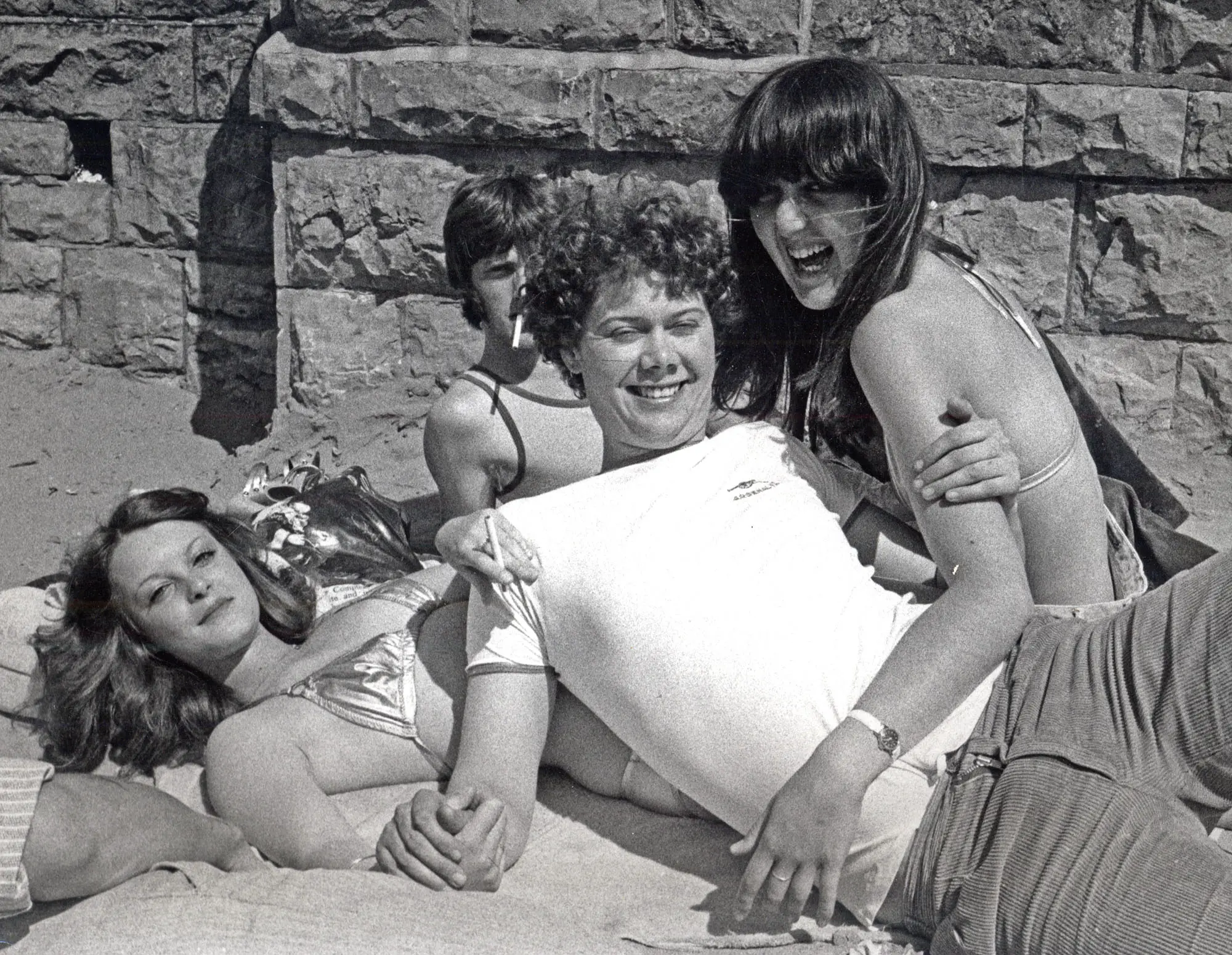
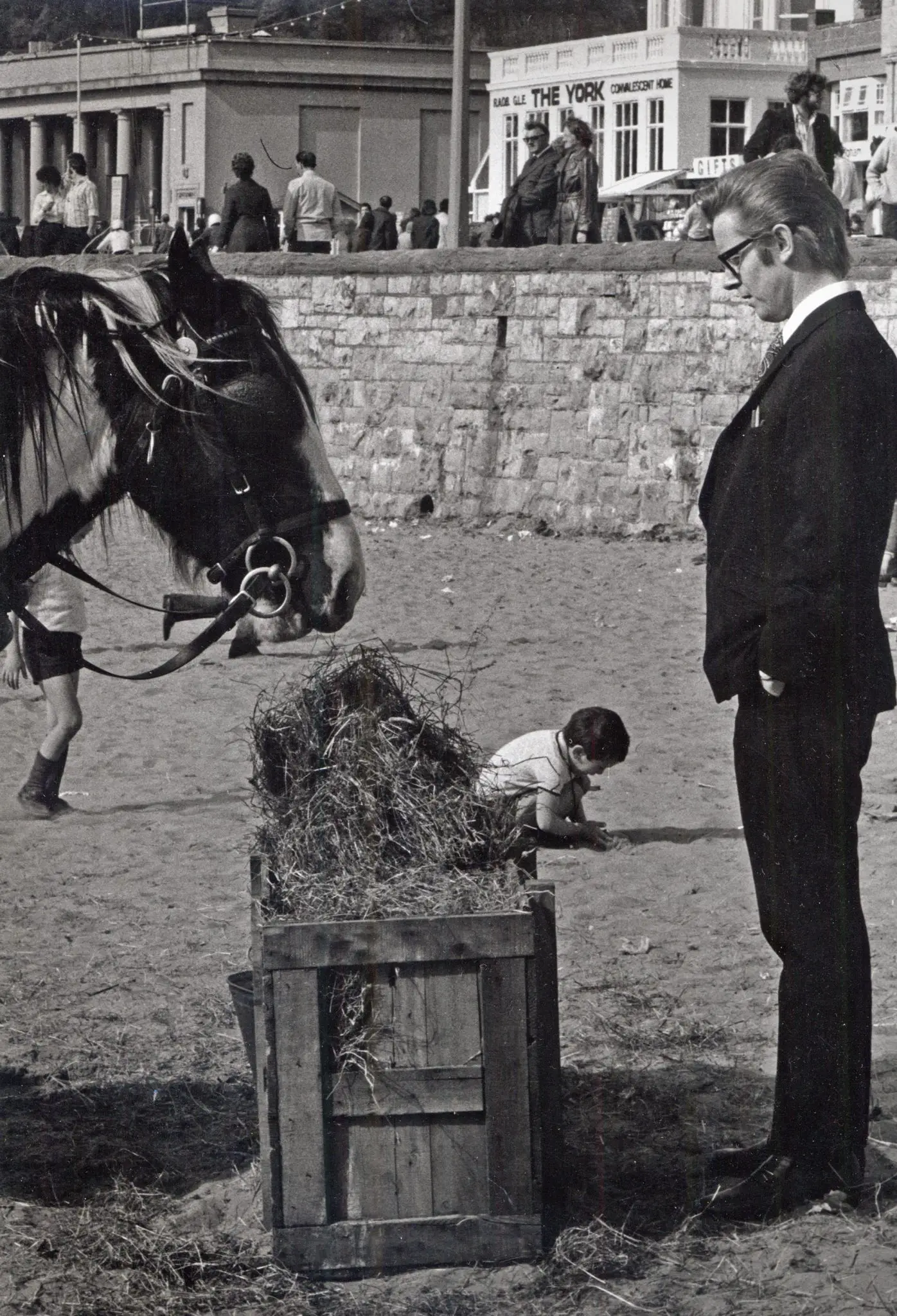
Another contender for The Greatest 35mm Compact might be the folding Kodak Retina series, 1934-1960. Again these underwent the same process of inflation as the Leica, gaining features such as lever wind and a better viewfinder in the process. All but the last models were much more angular than Leicas, but because they were folders they were extremely compact. Bellows are theoretically more fragile than retractable lenses, and there is more scope for misalignment between the lens and the film, but in practice, these are rarely if ever problems with Retinas. Far more of a problem nowadays is sheer wear, especially failure of the (subtractive) film counter: the newest Retina folder is now approaching 60 years old. Even so, a 1950s Retina IIa with its lever wind and an f/2 Schneider or Rodenstock lens is arguably a better pocket camera than the majority of screw-mount Leicas.
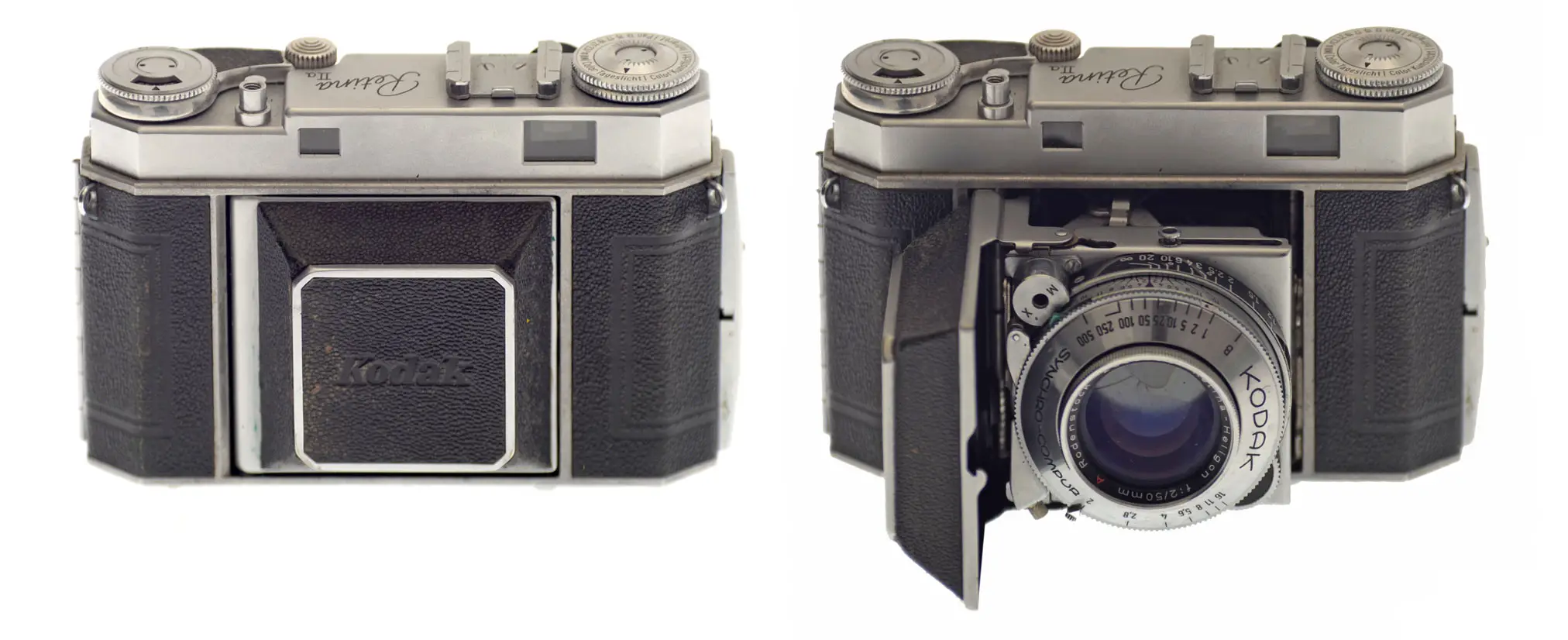
At this point, you may be getting a bit suspicious, and rightly so: both the cameras I have recommended so far ceased production in the 1950s. Surely there must be something more recent? Well, yes, but to stay with the ideal in pocketability we still need a short focal length; or a folder; or a retractable lens, because a non-retractable 50mm lens is likely to be inconveniently bulky.
Several cameras have gone with 35mm lenses, or occasionally even wider. One of the best-known (and best) examples is the Olympus XA series, with their sliding covers. The original 1979 model had an extremely short-base rangefinder (16mm) and a 6-glass 5-group 35/2.8 lens with an extremely short back focus. It was also battery dependent, and its only concession to manual control (apart from focusing) was a +1.5 stop “backlight” control. There’s quite a bewildering range of later models, all with slower f/3.5 or f/4 lenses, all scale-focus or (in one case) fixed focus, all but one (the XA-1, with a selenium meter and f/4 lens) battery dependent, all without manual exposure control: the XA-4 with its 28/3.5 is the rarest. They tend to be “Marmite” cameras – love ’em or hate ’em – but to tell the truth, I’m simply indifferent: the absence of manual control rules ’em out for me.
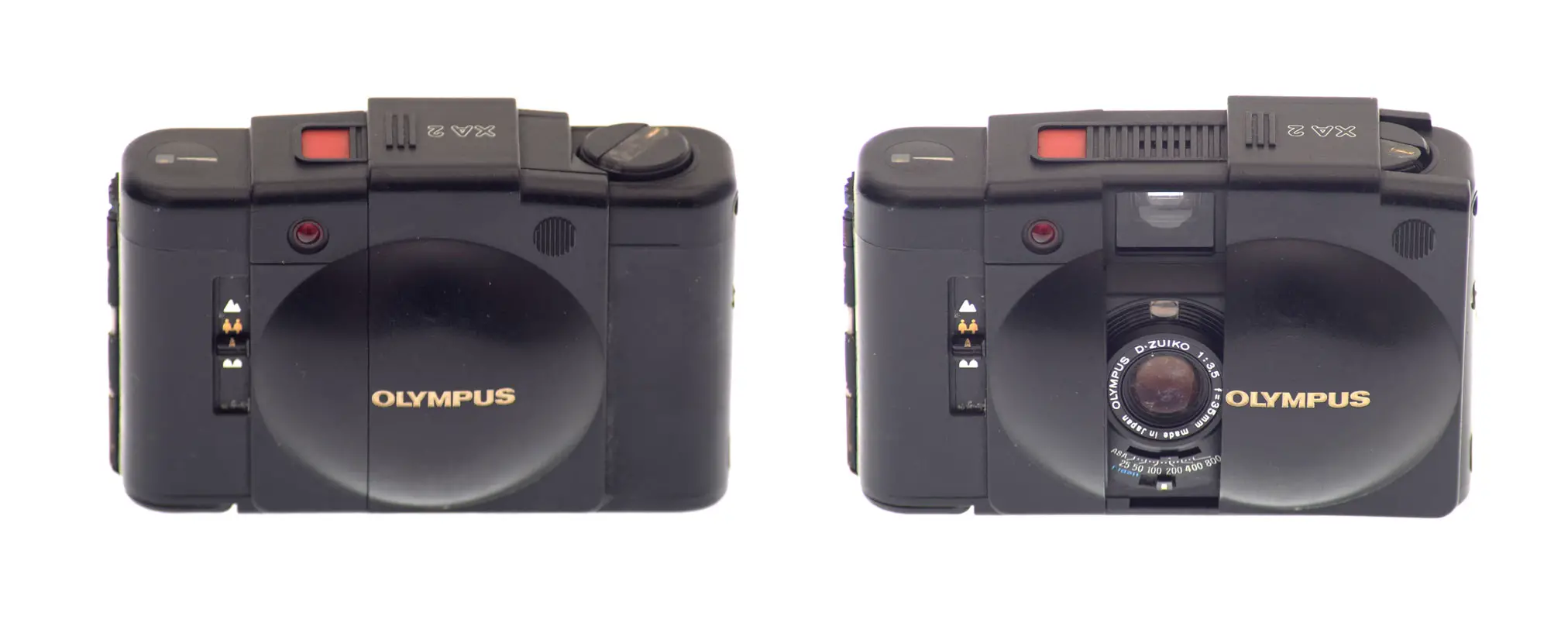
The early scale-focus Minox 35 (1974) combined a short lens (35/2.8) with a drop-down “folder” type front which protected the lens when folded and pulled it out to the operating position when opened; later models had autofocus and no lens protection. The drop-front ones, like the XAs, tend to be “love ’em or hate ’em”, but their popularity was further diminished by poor reliability, auto-only exposure, battery dependence and a tendency for some of the markings to rub off. Not that the last necessarily mattered: like the XA series, the numbers are really hard to see without perfect eyesight. The Contax T-series (introduced 1984) is similar but better made and more reliable.
Perhaps the best known reasonably modern “pocketable” camera with a retractable lens is the Rollei 35 series, introduced in 1966. Designed by Heinz Waaske when he was still at Wirgin, it was picked up by Franck and Heidecke when he moved there and remained in production until 2015, though production had been in fits and starts for several years before the last one was made. Fully manual, it’s technically fascinating. For example, the shutter blades in the sliding lens are controlled via a shaft from the all-mechanical timing mechanism in the camera body. It is however let down by a number of things. First, although it is tiny, it is also extremely boxy, with hard corners: it doesn’t just slide into the pocket like a Leica or Retina. Second, it is extremely idiosyncratic in the vintage German fashion, with fiddly controls, assorted interlocks (be careful with the collapsible lens) and a bottom-mounted rewind and accessory shoe. Third, it has a unique clip-on strap mount (!) instead of conventional strap lugs, and fourth, a unique lens cap (!!) with little cutaways for the “ears” on the focusing mount.
Many versions were made, with and without meters and with a choice of 40mm lenses from the basic 3-glass f/3.5 Triotar via the rather superior 4-glass, 3-group f/3.5 Tessar to the top of the line 5-glass, 3-group f/2.8 Sonnar. My wife Frances uses the one illustrated here.
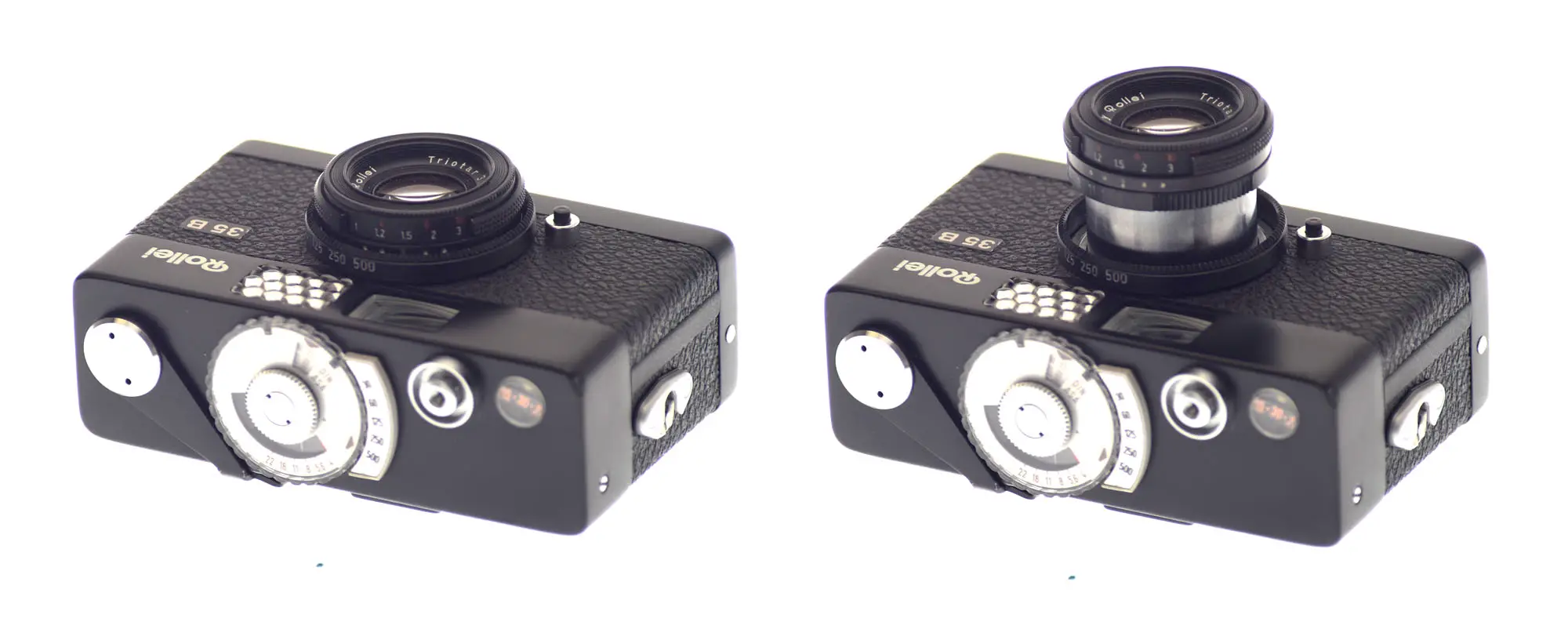
There are plenty of modern autofocus cameras with retractable lenses, but inevitably they are all battery dependent and few offer much in the way of manual control, though the Rollei AFM 35 offered manual focus override. My favourite was probably the Pentax Espio Mini/ UC-1, but it really was just a basic point-and-shoot with only its tiny size to recommend it. Even so, I’d probably still be using mine today if the rain hadn’t soaked through my motorcycle jacket and killed it. I’ve been a devotee of ZipLoc resealable plastic bags ever since.
Is there a modern camera that combines as many advantages as possible of all these flawed gems, while omitting as many as possible of the drawbacks? Not really. Take away battery dependency, and huge swathes of cameras disappear. Add manual controls, or even (in many cases) a decent viewfinder, and they almost all get bigger and heavier, and usually more expensive. Insist on a folding design or a collapsible lens and the choice really narrows down. In the end, it comes down to “Yer pays yer money and yer takes yer choice”. On the other hand, yer doesn’t necessarily need to pay that much of yer money. Or indeed any. I’ll come back to that in another post, where I look at free or very low-cost cameras. The next post, though, is about lenses.
Share this post:
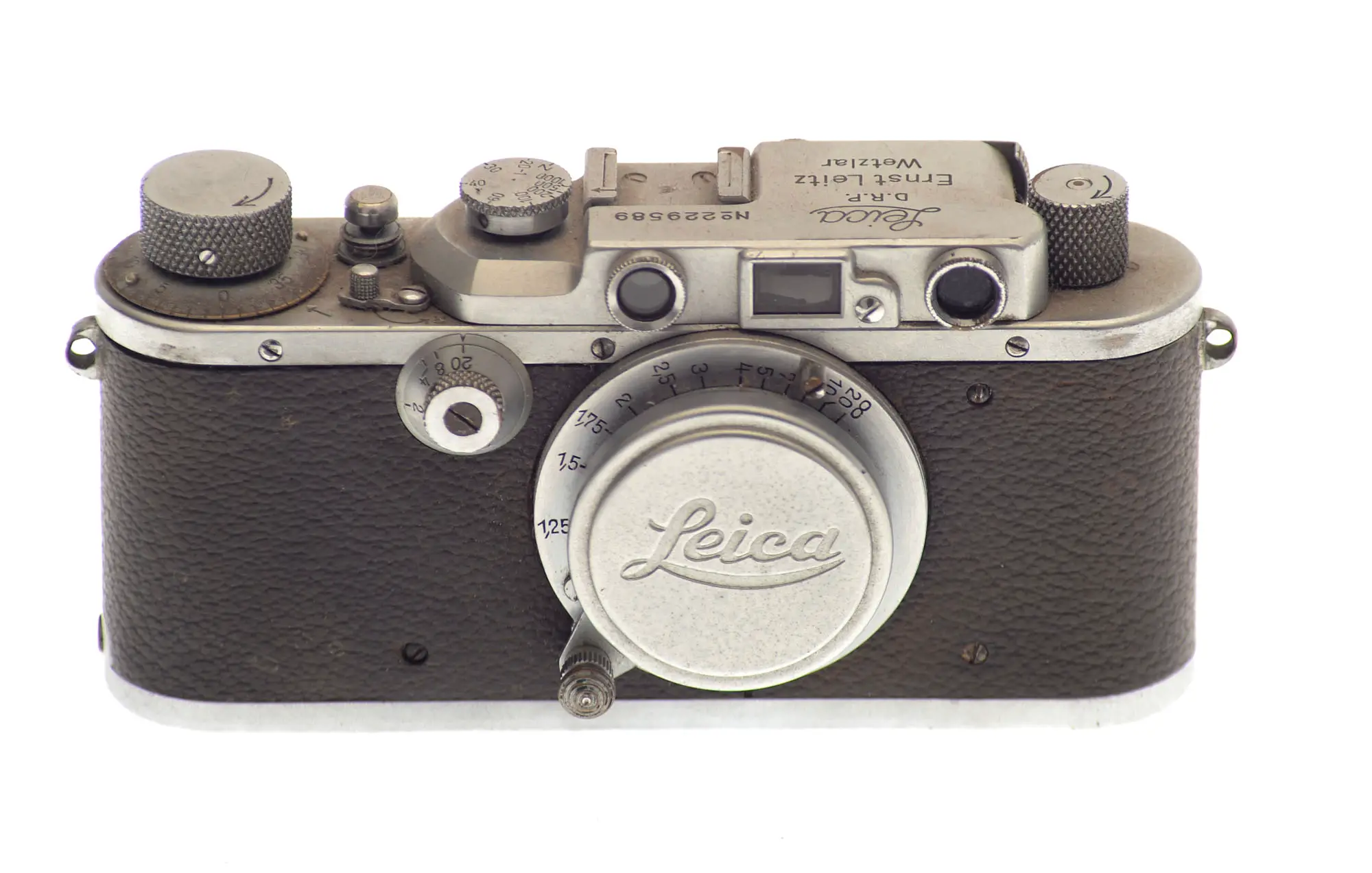








Comments
George Appletree on The Perfect 35mm Compact Camera – by Roger Hicks
Comment posted: 03/12/2017
karellen on The Perfect 35mm Compact Camera – by Roger Hicks
Comment posted: 03/12/2017
Teapoweredrobot on The Perfect 35mm Compact Camera – by Roger Hicks
Comment posted: 03/12/2017
One thing I don't understand is why people bemoan the XA for lack of manual control. You can choose your aperture and set your shutter speed/exposure compensation via the iso dial. With 100 speed film you get 3.5 to -3 EV manually selectable shutter speed variation from the meter setting in 1/3 stop increments between 2 and -3. How much more manual control do you need?! And it shows you the selected shutter speed in the viewfinder. But I'm an aperture priority shooter mostly so maybe it's just me!
Comment posted: 03/12/2017
Robert Smith on The Perfect 35mm Compact Camera – by Roger Hicks
Comment posted: 03/12/2017
Brian on The Perfect 35mm Compact Camera – by Roger Hicks
Comment posted: 03/12/2017
I like my Leica CL for a small compact, have a Nikkor 2.8cm/3.5 and 3.5cm/3.5- even smaller than the 40/2 Summicron. The Canon 50/1.5 (Sonnar) fits in the pouch-case. Battery runs the meter only.
Good to read Roger's article on this site.
Frank Lehnen on The Perfect 35mm Compact Camera – by Roger Hicks
Comment posted: 03/12/2017
But I adore my Leica IIIa because it gives me confidence that it will still work when I’ll be no more. Heavy, small viewfinder, nearly unusable with glasses, fiddly handling... but no way I’ll get along without it!
Best compact camera, ever!
Blinx on The Perfect 35mm Compact Camera – by Roger Hicks
Comment posted: 03/12/2017
If you're going out to photograph, rather than pursue normal life with the option of shooting opportunely, factors like well spaced control surfaces and easily focused finders lend themselves to a different category of camera. In that case rangefinders, small SLRs, bridge cameras and folders make more sense than an inevitably compromised pocket P&S.
Ken Hindle-May on The Perfect 35mm Compact Camera – by Roger Hicks
Comment posted: 05/12/2017
Kodachromeguy on The Perfect 35mm Compact Camera – by Roger Hicks
Comment posted: 06/12/2017
An option for your survey of compacts: The Olympus Trip 35. It fits many of your criteria and even uses a selenium light meter, so no batteries. Its failing is the automatic exposure system and limitation of two shutter speeds, 1/40 and 1/200. But the optical quality is amazing, and it has a 1970s mechanical precision feel. Cheers,
Evan Bedford on The Perfect 35mm Compact Camera – by Roger Hicks
Comment posted: 07/12/2017
Oh yeah, I sold the F3. Can't remember why. Still have the Nikkor (use it on a Sony A7s; horrors!). But I still have my Plaubel 6x7 Proshift (yes, 6x7; I'm a tinkerer). But I've gone past 35mm now, so I'll shut up.
jeremy north on The Perfect 35mm Compact Camera – by Roger Hicks
Comment posted: 08/12/2017
Do you still have your Land Rover and live in France?
Getting back to the camera stuff. I agree with you about manual control. The Rollei 35 gets my vote but for the lack of a rangefinder.I've not used a pre M leica but I love the size and feel.
Floyd Takeuchi on The Perfect 35mm Compact Camera – by Roger Hicks
Comment posted: 08/12/2017
The lens on these cameras was a Zeiss Tessar 45mm F2.8. I fitted a modern Voigtlander 50mm viewfinder into the cold shoe and find it easier to frame rather than the camera's squinty viewfinder (though the rangefinder patch is clear and easy to use). I find the Tessar does particularly well with modern color films -- good contrast, fairly punchy colors.
I also own a Rollei B35, which is referenced in the article. While I like the B35, the Contessa 35's lens is noticeably sharper than the 3-element Triotar, and it's much easier to load film with the Contessa 35. I invested in a full overhaul by Zeiss specialist Henry Scherer -- the Contessa 35 is such a solid performer that the overhaul was well worth the price.
dmitrizzle on The Perfect 35mm Compact Camera – by Roger Hicks
Comment posted: 24/02/2018
Charles Vernon Watson on The Perfect 35mm Compact Camera – by Roger Hicks
Comment posted: 22/07/2018
Rob on The Perfect 35mm Compact Camera – by Roger Hicks
Comment posted: 31/03/2019